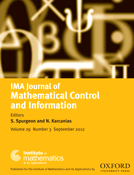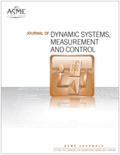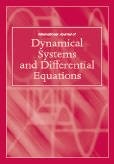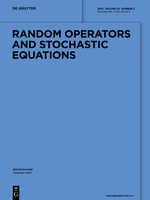
IMA JOURNAL OF MATHEMATICAL CONTROL AND INFORMATION
Scope & Guideline
Connecting Theory to Practice in Control and Information Science.
Introduction
Aims and Scopes
- Mathematical Control Theory:
The journal covers a wide range of topics within mathematical control theory, including stability, controllability, and optimal control of dynamic systems. It emphasizes both linear and nonlinear systems, providing a rigorous mathematical framework for analyzing and designing control strategies. - Information Systems and Data Processing:
Research related to the integration of information systems with control theory is a key focus. This includes studies on observer design, state estimation, and fault diagnosis within the context of control systems, highlighting the importance of data in effective system management. - Application of Advanced Mathematical Techniques:
The journal promotes the use of advanced mathematical techniques such as differential equations, stochastic processes, and fractional calculus in control theory. This includes exploring novel approaches to solve complex control problems and improve system robustness. - Multi-Agent Systems and Networked Control:
A significant area of interest is the control of multi-agent systems, including consensus protocols and cooperative control strategies. This reflects the growing relevance of networked systems in modern applications, such as autonomous vehicles and smart grids. - Interdisciplinary Applications:
The journal encourages research that applies mathematical control principles to various fields, including engineering, economics, and biology. This interdisciplinary approach fosters the development of innovative solutions to real-world problems.
Trending and Emerging
- Adaptive and Robust Control Strategies:
There is a growing emphasis on adaptive and robust control techniques that can handle uncertainties and variations in system dynamics. This trend reflects the increasing complexity of real-world systems that require flexible and resilient control solutions. - Stochastic and Hybrid Systems:
Research on stochastic systems and hybrid control strategies is on the rise, particularly those that integrate elements of randomness and time delays. This trend is crucial for applications in fields such as finance, robotics, and networked systems, where uncertainty is a significant factor. - Integration of Machine Learning with Control Systems:
The intersection of machine learning and control systems is emerging as a prominent theme. Researchers are exploring how machine learning techniques can enhance control strategies, improve system performance, and enable more intelligent decision-making processes. - Nonlinear and Fractional Order Systems:
There is an increasing interest in the control of nonlinear and fractional-order systems. This reflects a broader trend in the field towards addressing the complexities of real-world systems that cannot be adequately modeled by traditional integer-order linear equations. - Networked Control Systems and Distributed Algorithms:
The study of networked control systems, particularly those employing distributed algorithms for consensus and coordination among agents, is gaining traction. This is particularly relevant in the context of the Internet of Things (IoT) and autonomous systems, where communication and collaboration are essential.
Declining or Waning
- Traditional Linear Control Techniques:
There has been a noticeable decrease in publications focusing solely on traditional linear control methods. As the field evolves, researchers are increasingly exploring more complex nonlinear and adaptive control strategies, leading to a reduced emphasis on classical linear approaches. - Basic Stability Analysis:
The frequency of papers centered on basic stability analysis of linear systems has waned. This shift may be due to the growing sophistication in stability analysis techniques, such as those incorporating stochastic elements or time delays, which are now more prevalent. - Static Optimization Problems:
Research focused on static optimization problems, particularly in isolation from dynamic systems, has diminished. The trend is shifting towards dynamic optimization problems that consider time-varying parameters and constraints, reflecting a more comprehensive understanding of real-world systems.
Similar Journals

Journal of Systems Science & Complexity
Advancing Knowledge in Computer Science and Information Systems.The Journal of Systems Science & Complexity, published by SPRINGER HEIDELBERG, stands as a leading forum for innovative research in the fields of computer science and information systems. With an ISSN of 1009-6124 and an E-ISSN of 1559-7067, this journal has established itself within the academic community, garnering a commendable impact factor that reflects its influential contributions. Operating from 2006 and continuing through 2024, it is categorized in the Q2 quartile for both Computer Science (Miscellaneous) and Information Systems, indicating its quality and relevance. Recognized within Scopus rankings, it places 52nd out of 133 in its specific field, affirming its significance in advancing systems science discussions. Researchers and professionals will find a wealth of knowledge through rigorous peer-reviewed articles that explore complex systems and their applications, enabling readers to stay at the forefront of technological advancements and interdisciplinary collaboration.

Journal of Applied Mathematics and Computing
Advancing the Frontiers of Mathematical InnovationThe Journal of Applied Mathematics and Computing, published by SPRINGER HEIDELBERG, is a premier open-access journal dedicated to the advancements and interdisciplinary applications of mathematical theory and computing techniques. Since its inception in 1997, this journal has become a vital resource for researchers and practitioners, contributing significantly to the fields of Applied Mathematics and Computational Mathematics, currently positioned in the Q2 category as per the 2023 metrics. With an impressive Scopus ranking of #130 out of 635 in Applied Mathematics and #48 out of 189 in Computational Mathematics, it reflects a robust academic influence and a dedication to high-quality research dissemination. The journal's accessibility as an open-access resource since 2002 ensures that its groundbreaking findings are available to a global audience, fostering collaboration and innovation in the mathematical sciences. Based in Heidelberg, Germany, the journal continues to invite contributions that push the boundaries of both theory and practical applications, making it an essential platform for scholars, professionals, and students alike.

JOURNAL OF DYNAMIC SYSTEMS MEASUREMENT AND CONTROL-TRANSACTIONS OF THE ASME
Charting the course for excellence in measurement and control.JOURNAL OF DYNAMIC SYSTEMS MEASUREMENT AND CONTROL - TRANSACTIONS OF THE ASME is a renowned periodical published by the American Society of Mechanical Engineers (ASME), focused on advancing the field of dynamic systems, measurement, and control. With a rich publication history spanning from 1971 to 2025, this journal serves as a pivotal platform for disseminating high-quality research aimed at enhancing understanding and innovation in various sectors, including mechanical engineering, control and systems engineering, and information systems. The journal currently holds a respectable Q2 category ranking in multiple fields, reflecting its commitment to excellence and rigorous peer-review standards. Although it does not offer open access, its extensive reach within the academic community exemplifies its significance, making it an indispensable resource for researchers, professionals, and students eager to engage with cutting-edge advancements. For those seeking to expand their knowledge and contribute to the dialogue surrounding dynamic systems and control mechanisms, JOURNAL OF DYNAMIC SYSTEMS MEASUREMENT AND CONTROL stands out as a critical reference.

Differential Equations & Applications
Advancing the Frontiers of Differential EquationsDifferential Equations & Applications is a distinguished academic journal published by ELEMENT, focusing on the ongoing advancements in the field of differential equations and their applications across various scientific disciplines. With an ISSN of 1847-120X and an E-ISSN of 1848-9605, this journal serves as a vital platform for researchers, professionals, and students alike to present their findings and contribute to the expanding knowledge base within this critical area of mathematics. Although currently a subscription-based publication, it provides comprehensive access to high-quality peer-reviewed articles that rigorously explore both theoretical and practical aspects of differential equations. The journal aims to foster collaboration and dissemination of knowledge, enhancing the understanding of complex systems modeled by differential equations. As it continues to grow its impact in the scholarly community, Differential Equations & Applications stands as a valuable resource for anyone engaged in mathematical research and its applications in scientific endeavors worldwide.

International Journal of Dynamical Systems and Differential Equations
Pioneering Insights into Differential EquationsThe International Journal of Dynamical Systems and Differential Equations, published by INDERSCIENCE ENTERPRISES LTD, is an esteemed academic journal that focuses on the intricate mathematical theories and applications of dynamical systems and differential equations. Established in the United Kingdom, this journal plays a critical role in advancing research within its scope, which includes control optimization, discrete mathematics, and engineering. Despite its recent rankings indicating a Q4 status in Control and Optimization and Discrete Mathematics, along with a Q3 position in Engineering, the journal provides a vital platform for scholars to disseminate their findings and engage with ongoing debates in these fields. Researchers and students alike benefit from the journal's commitment to fostering innovative ideas and methodologies, contributing to the development of mathematical sciences. Although currently not an open-access publication, the journal's archives from 2007 to 2023 include valuable research articles that continue to influence the landscape of mathematical explorations.

Random Operators and Stochastic Equations
Pioneering Advances in Stochastic ProcessesRandom Operators and Stochastic Equations, published by WALTER DE GRUYTER GMBH in Germany, is a pivotal journal dedicated to the exploration of stochastic processes and their applications in various fields of mathematics and statistics. With its ISSN 0926-6364 and E-ISSN 1569-397X, this journal has been a platform for researchers since its inception in 1993 and is anticipated to continue until 2024. Although it currently holds a Q4 category ranking in both Analysis and Statistics and Probability for 2023, it provides invaluable insight and contributions that cater to both academic circles and practical applications. The journal is accessible via traditional subscription methods, making it a crucial resource for professionals and students seeking rigorous research in stochastic analysis. As it navigates through novel developments and theoretical advancements, Random Operators and Stochastic Equations stands as a significant forum for scholarly dialogue in its field.

JOURNAL OF DYNAMICAL AND CONTROL SYSTEMS
Unraveling Complexities in Dynamical Systems and OptimizationJOURNAL OF DYNAMICAL AND CONTROL SYSTEMS is a premier interdisciplinary journal published by Springer/Plenum Publishers, recognized for its significant contributions to the fields of dynamical systems, control theory, and numerical analysis. With an ISSN of 1079-2724 and an E-ISSN of 1573-8698, the journal serves as an important platform for researchers and professionals to share their findings and innovative methodologies. Covering topics from algebra and number theory to control and optimization, it holds a respectable position in the 2023 Q2 quartile rankings across various categories, reflecting its impact and quality within the academic community. The journal’s scope is expansive, aiming to foster advancements and insights that are instrumental for academics and industry experts alike. With a convergence period from 1995 to 2024, the journal continues to be a vital resource for students, researchers, and professionals seeking to navigate the complexities of control systems and their dynamic interactions. For those looking to contribute to the ongoing discourse in these critical areas of study, the JOURNAL OF DYNAMICAL AND CONTROL SYSTEMS remains a highly recommended choice.

Nonlinear Analysis-Modelling and Control
Empowering the global mathematical community with open access.Nonlinear Analysis-Modelling and Control is a leading open-access journal published by the Vilnius University, Institute of Mathematics and Informatics, nestled in the heart of Lithuania. Since its inception in 2009, the journal has been committed to advancing the field of nonlinear analysis through rigorous research and comprehensive modelling techniques. With an impressive Q2 category ranking in both Analysis and Applied Mathematics for 2023, it stands out with its strong academic influence reflected in its Scopus ranking, where it is positioned in the top 12% percentile for Mathematics - Analysis and the top 24% for Mathematics - Applied Mathematics. This journal not only serves as a platform for pioneering research but also emphasizes interdisciplinary collaboration in addressing complex mathematical and control problems. Its open-access policy since 2017 ensures that its findings are readily accessible to a global audience, fostering knowledge dissemination and innovation across the mathematical community. Researchers, professionals, and students will find Nonlinear Analysis-Modelling and Control an essential resource for the latest developments and applications in nonlinear systems.

Trudy Instituta Matematiki i Mekhaniki UrO RAN
Pioneering Research in Computational Mechanics and MathematicsTrudy Instituta Matematiki i Mekhaniki UrO RAN, a prestigious journal published by the KRASOVSKII INST MATHEMATICS & MECHANICS URAL BRANCH RUSSIAN ACAD SCIENCES, serves as a vital platform for the dissemination of research in the diverse fields of applied mathematics, computational mechanics, and computer science applications. With a dedicated focus on advancing theoretical and practical applications within these disciplines, the journal emphasizes innovative methodologies and novel concepts that are crucial in an era where mathematical techniques are increasingly intertwined with emerging technologies. Although currently not an open-access publication, the journal caters to a niche yet expansive audience of researchers, academics, and professionals, providing insights into current trends and breakthroughs. Notably, it holds a commendable position in various quartiles — Q3 in Applied Mathematics and Q2 in Computational Mechanics as of 2023, reflecting its growing influence within the scientific community. While its Scopus rankings indicate a competitive landscape, this journal continues to be a significant resource for scholarly discourse, making substantial contributions to the body of knowledge for its readers based in the Russian Federation and beyond.

Proceedings of the Institute of Mathematics and Mechanics
Exploring New Dimensions in Mathematics and MechanicsProceedings of the Institute of Mathematics and Mechanics is a pivotal journal in the field of mathematics, dedicated to the advancement and dissemination of cutting-edge research in various sub-disciplines. Published by INST MATHEMATICS & MECHANICS, NATL ACAD SCIENCES AZERBAIJAN, this journal plays a significant role in bridging local and international research communities. With an ISSN of 2409-4986 and E-ISSN of 2409-4994, it has gained recognition, attaining a Q3 ranking in the Miscellaneous Mathematics category and placing in the 67th percentile on Scopus. Run from 2017 to 2024, the journal serves as an accessible platform for scholars and practitioners, inviting contributions that advance theoretical knowledge and practical applications in mathematics. With an emphasis on quality and innovation, the Proceedings of the Institute of Mathematics and Mechanics stands out as a vital resource for those looking to stay at the forefront of mathematical research and its multifaceted applications in various fields.